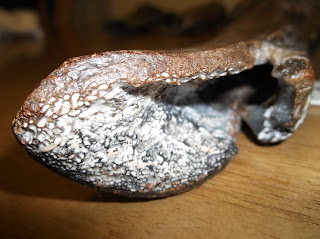1 Note the top of the eye socket is not fully formed.
This horse skull piece is from the lake bed deposits at Stainsby beck.
Many mammals have a small supra-orbital foramen just above the eye socket which communicates from the outside surface of the skull above the orbit to the interior of the orbital cavity. Sometimes this foramen fails to fully form, and is open to the edge of the orbital rim, as in your horse.
The explanation above is from Richard White a Palaeontologist from Tucson in the United States, a trusted friend and advisor.
 1- This Horse metatarsal was recently excavated from the same section of previously undisturbed gravel bed at Stainton.
1- This Horse metatarsal was recently excavated from the same section of previously undisturbed gravel bed at Stainton. 2 - The black flint scraper was excavated from the bed just to the right of the bottom of the spade, The metatarsal was excavated from slightly further in to the gravel bed. The gravel beds have been dated between 12 to 16,000 ybp this would make these finds almost certainly Mesolithic.
2 - The black flint scraper was excavated from the bed just to the right of the bottom of the spade, The metatarsal was excavated from slightly further in to the gravel bed. The gravel beds have been dated between 12 to 16,000 ybp this would make these finds almost certainly Mesolithic. 4 - Note the gloss like shine almost all of the bone samples I have excavated from the gravel beds have this shine, nothing has been applied i.e. polish, the bone has been washed dried and rubbed with a cloth nothing more.
4 - Note the gloss like shine almost all of the bone samples I have excavated from the gravel beds have this shine, nothing has been applied i.e. polish, the bone has been washed dried and rubbed with a cloth nothing more. 













































